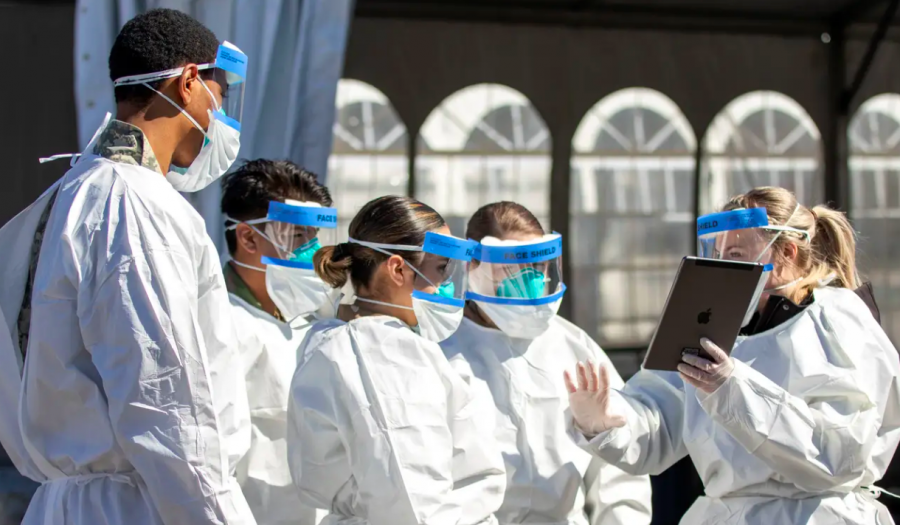Distinguishing Between Fact and Fiction: Coronavirus Conspiracy Theories
March 8, 2020
As the coronavirus becomes an increasingly prevalent issue, an epidemic of fake news surges with it. There have been many conspiracy theories and waves of inaccurate information spread across the internet. This false information includes everything from incorrect health advice to speculations of “spy teams” and planned outbreaks. These conspiracies make it increasingly difficult to know the facts about the coronavirus, causing a lack of clarity around this pressing issue.
As the panic surrounding the coronavirus continues, social media users share their opinions, often mistaken for facts, on how to treat and prevent the disease. Many of these tips have been proven to be misleading at the least.
According to BBC News, someone made a claim, shared 16,000 times on Facebook, advising each viewer to “‘keep your throat moist’, avoid spicy food and ‘load up on vitamin C’ in order to prevent the disease.” This claim was said to be from the Philippines Department of Health but neither matches the advice on the DOH website nor its official press releases about the virus.
Another similar claim reported by BBC instructs people to avoid “cold or preserved food and drinks, such as ice cream and milkshakes, for ‘at least 90 days’.”
Common speculation surrounding the coronavirus about its origin has sparked racism and extreme accusations. One theory was emphasized by a slew of videos that appeared to show Chinese people eating bats amid the deadly outbreak in Wuhan.
One clip that went viral shows a Chinese woman holding a cooked bat on camera, before stating that it tasted “like chicken meat.” The video prompted outrage online and sparked racism. Some users blamed speculated “Chinese eating habits” for the outbreak but were proved wrong when the video was revealed to not have even been shot in China. It was filmed in 2016 in Palau, an archipelago in the western Pacific Ocean.
When the United States reported its first case of the coronavirus, several documents circulated on the internet that implied that experts had been aware of the virus for years.
Conspiracy Theorist Jordan Sather was one of the first people to send out these allegations in a long thread that has been retweeted thousands of times. In this tweet, Sather shared a link to a 2015 patent filed by the Pirbright Institue in Surrey, England. The patent talks about developing a weakened version of the coronavirus for a potential vaccine to prevent and treat various respiratory diseases in birds and other animals instead of the implied purpose to spread the virus.
Building on Sather’s allegations, many paranoid social media users connected the Pirbright Institute to the Bill & Melinda Gates Foundation grant to study livestock antibiotics. Sather encouraged this idea, saying that the outbreak had somehow been manufactured to attract funding for the development of a vaccine.
“And how much funding has the Gates Foundation given to vaccine programs throughout the years? Was the release of this disease planned? Is the media being used to incite fear around it?” Sather tweeted.
This theory was debunked when it was proved that Pirbright’s patent is not for the new coronavirus. It actually covers the avian infectious bronchitis virus; a member of the wider coronavirus family that infects poultry. To clear the speculation around the Bill and Melinda Gates Foundation, Teresa Maughan, a Pirbright spokeswoman told Buzzfeed News that the institute’s work with the bronchitis infection was not funded by the foundation.
Another viral claim suggests that the coronavirus was a bioweapon used by China’s “covert biological weapons program” and that it was leaked from the Wuhan Institute of Virology. This baseless theory was encouraged by many internet users, quoting Israeli military intelligence articles for attempted support. This “evidence” was debunked when the Israeli source quoted that “so far there isn’t any evidence or indication to suggest there was a leak.”
There was also a similar article published in the Daily Star that claimed that the virus possibly “started in a secret lab” in an undisclosed location. The newspaper has since adjusted the article, correcting this theory by adding that there is no evidence to support this claim.
Suggestions have circulated the internet that a Chinese Spy team sent the coronavirus to China from a research lab in Canada. This theory came when a Twitter user tweeted, “A husband and wife Chinese spy team were recently removed from a Level 4 Infectious Disease facility in Canada for sending pathogens to the Wuhan facility. The husband specialized in coronavirus research.”
Virologist Dr. Xiangguo Qui, her husband, and some of her students from China were suspended from Canada’s National Microbiology Lab due to a possible policy breach. This was recorded in a report by Canada’s national broadcaster CBC last year. Police provided clarity to the situation, saying that there was “no threat to public safety,” therefore proving that the policy breach had nothing to do with coronavirus.
The allegations about Dr. Qiu did not stop there, as another report circulated the internet saying that twice a year, she would visit the Wuhan National Biosafety Laboratory of the Chinese Acadamy of Sciences. This report supported the conspiracy that she was a spy playing a crucial role in the outbreak. CBC has debunked all of these claims, releasing a statement that they are all baseless.
It is important that you get your information about the coronavirus from a reliable source and stay aware of the fake news that plagues the internet. Many of these conspiracies have been debunked, but it still is difficult to differentiate conspiracy from fact. If you want to learn about the facts about the virus, turn to health officials for the most recent updates.




